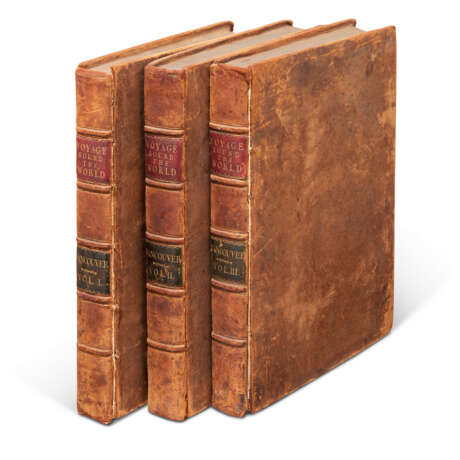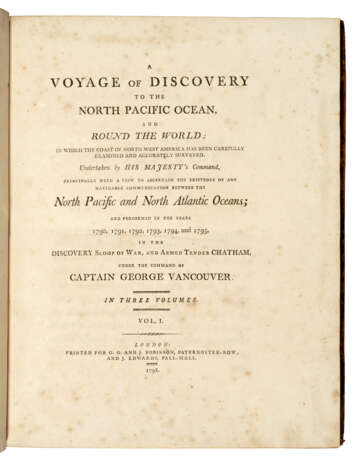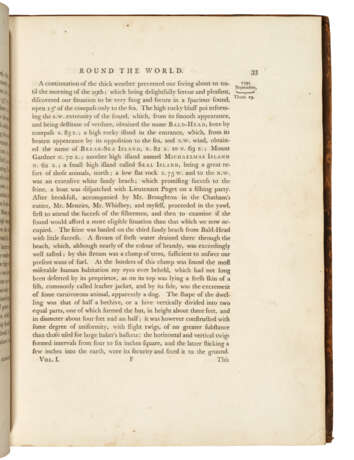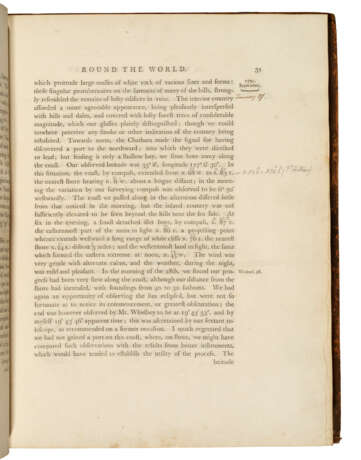ID 1349759
Los 129 | VANCOUVER, George (1757-1798)
Schätzwert
£ 40 000 – 60 000
A Voyage of Discovery to the North Pacific Ocean, and Round the World; in which the coast of North-west America has been carefully examined and accurately surveyed ... and performed in the years 1790, 1791, 1792, 1793, 1794, and 1795. London: Printed for G. G. and J. Robinson and J. Edwards, 1798. [Text volumes only].
Matthew Flinders’ own copy of Vancouver’s Voyage, almost certainly taken with him aboard HMS Investigator on the first circumnavigation of Australia. With autograph annotations by Flinders amending Vancouver’s geographical co-ordinates, correcting the name of an island in modern-day French Polynesia and giving the name of the wife of the first Tahitian King.
The Voyage of Captain George Vancouver, who had served on Captain Cook's second and third voyages, ranks among the most important in exploration literature. Beginning from England in 1791, he sailed by way of the Cape of Good Hope to Australia, where he discovered King George's sound and Cape Hood, then to New Zealand, and Hawaii, before surveying the coast of California, visiting San Francisco and San Diego, meeting with the Spanish at Nootka, investigating the Strait of Juan de Fuca, discovering the Strait of Georgia, circumnavigating Vancouver Island and disproving the existence of a passage between the Pacific and Hudson's Bay. The present first edition was published by his brother John with the assistance of Captain Peter Puget shortly after Vancouver’s early death.
According to Kenneth Morgan’s 2016 biography, ‘Flinders had a copy of [Vancouver’s] voyage account with him. He used this with his charts to confirm numerous references to Vancouver’s discoveries in the vicinity’ (p.72). Indeed, references to Vancouver’s account of the South Australian coast are frequent in Flinders’ Terra Australis and appear to confirm its presence in the library of HMS Investigator, alongside other ‘books of voyages to the South Seas’ which furnished Flinders’ cabin. For example, on 9 December 1801, Flinders aims to locate suitable shelter on King George's Sound based on ‘Vancouver’s chart and description’; while on the same day he ‘ascended the hill to search for the bottle and parchment left by captain Vancouver in 1791’, as described on p.40 in vol. I of the present set.
Flinders’ annotations occur in pencil across 4 pages of vol. I. The first two of these annotations are amendments to geographical co-ordinates relating to Point Hillier on Stanley Island and to the waters around a ‘small detached islet’ off West Cape Howe. Both points are described by Flinders in Terra Australis (pp.52-53, vol. I), and the matter of the ‘small detached islet’ is explained with direct quotation from the passage in Vancouver’s voyage where the annotation is to be found. An annotation to p.79 crosses through the printed name ‘Matavai’ and replaces it in the margin with ‘Maitea’ as the indigenous name for Osnaburgh Island in modern-day French Polynesia. On p.110, Flinders enters the name ‘Edea’ for the wife of Pōmare I, the unifier and first king of Tahiti and founder of the Pōmare dynasty. Additional annotations in ink, correcting printed errors according to the printed errata leaves in vol. III and adding implied dates in the margins, occur across 13 pages in an unidentified contemporary hand. Hill 1753; Howes V23; Lada-Mocarski 55; Lande 1495; Morgan, Matthew Flinders, Maritime Explorer of Australia (London: Bloomsbury, 2016); NMM 142; Sabin 98443; Staton & Tremaine/TPL 688; Wagner I, pp.239-50.
3 volumes, quarto (302 x 239mm). Half-titles. 18 engraved plates after W. Alexander by J. Landseer, J. Fittler and others (a few marginal chips or tears, some staining to plates, a few small ink stains). Contemporary speckled calf, spines with red and green morocco spine labels lettered in gilt (extremities somewhat rubbed, two boards detached).
| Künstler: | George Vancouver (1757 - 1798) |
|---|---|
| Herkunftsort: | Nordeuropa, Europa, Vereinigtes Königreich |
| Kategorie des Auktionshauses: | Bücher und Handschriften, Gedruckte Bücher |
| Künstler: | George Vancouver (1757 - 1798) |
|---|---|
| Herkunftsort: | Nordeuropa, Europa, Vereinigtes Königreich |
| Kategorie des Auktionshauses: | Bücher und Handschriften, Gedruckte Bücher |
| Adresse der Versteigerung |
CHRISTIE'S 8 King Street, St. James's SW1Y 6QT London Vereinigtes Königreich | |
|---|---|---|
| Vorschau |
| |
| Telefon | +44 (0)20 7839 9060 | |
| Aufgeld | see on Website | |
| Nutzungsbedingungen | Nutzungsbedingungen |






